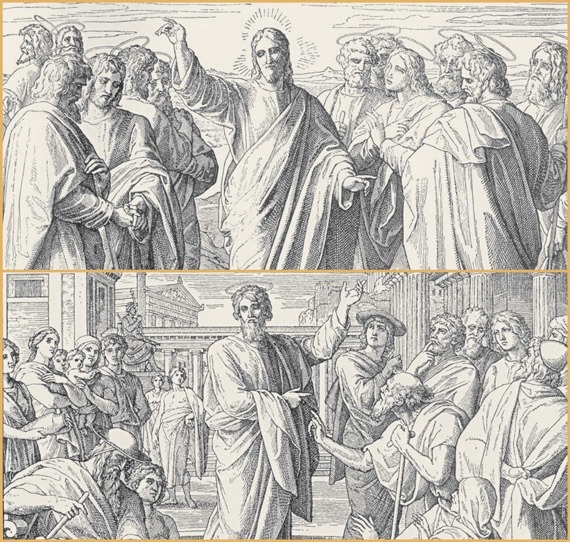This article first appeared in CHRISTIAN RESEARCH JOURNAL, volume 35, number 03 (2012). The full text of this article in PDF format can be obtained by clicking here. For further information or to subscribe to the CHRISTIAN RESEARCH JOURNAL go to: http://www.equip.org/christian-research-journal/
In an article published in Christianity Today, Scot McKnight helpfully raised the important question of the relationship between Jesus and Paul.1 He suggested, “Jesus preached almost exclusively about the kingdom of heaven, while Paul highlighted justification by faith—and not vice versa.” He pointed out the evangelical crisis of choosing between Jesus and Paul and came up with the solution that grounds kingdom vision and justification on the gospel of Jesus. The gospel (good news) is “the saving story of Jesus that completes Israel’s story.” Both Jesus’ kingdom vision and Paul’s justification speak of Jesus as the one who completes Israel’s story. Therefore, both belong to the one gospel story of Jesus. Hence, according to McKnight, we find the unity between Jesus and Paul. But he weakens this unity by splitting Paul’s justification from Jesus’ kingdom vision so that in the end Jesus and Paul are still materially divided in his scheme. For him, both kingdom vision and justification speak of Jesus but they do so in very different and minimally overlapping ways. This article will show that this division between Jesus’ kingdom vision and Paul’s justification is not warranted by the New Testament, and that the division and so-called crisis dissolve when Jesus and Paul are interpreted in fuller manners in terms of God’s kingdom.
RELATIONSHIP BETWEEN THE KINGDOM OF GOD AND THE GOSPEL
The gospel is the good news of the kingdom of God as attested by the following Bible verses: Matthew 4:23, 9:35, 24:14; Mark 1:15; Luke 4:43, 8:1, 16:16; Acts 8:12, 20:24–25. A piece of news must have content. In the case of the gospel (good news) of Jesus Christ, the content of the good news is the dawning of the kingdom of God through His very own presence. This is exactly what happened when Jesus came on the public scene at the beginning of His ministry and proclaimed, “The Kingdom of God has come near. Repent and believe the good news!” (Mark 1:15 TNIV). The news is that God’s kingdom has drawn near. With this under- standing, we see that the kingdom of God is not subsumed under “good news” merely as one of its components but is its entire content (contra McKnight).
But what is the kingdom of God? Perhaps the best definition of God’s kingdom comes from Jesus’ teaching on the Lord’s Prayer. There, He taught us to pray, “Our Father in heaven, hallowed be your name, your kingdom come, your will be done on earth as it is in heaven.” Where God’s will is obeyed and done by His people, and therefore where His name is honored, there we find the kingdom of God. Because Jesus, the perfect Son of God, fully obeyed His Father’s will and honored His Father’s name on earth, He is the one who brought in the kingdom of God, His Father’s kingdom. We can therefore safely use the term “kingdom of God” to cover (1) all that Jesus did in His earthly life, and (2) what He continues to do through His church in the world. In this article for its purpose, we shall mainly limit ourselves to the former.
In His earthly existence, where the King (Jesus) is, there is the kingdom; where the Lord Jesus is exercising His Father’s will in the power of the Holy Spirit, there is the presence of the kingdom (cf. Matt. 12:28). We now turn to how Jesus brings the presence of the kingdom on earth.
FULL VISION OF GOD’S KINGDOM: IDENTIFICATION WITH THE PHYSICALLY POOR AND THE SPIRITUALLY POOR
The poor circumstances of Jesus’ birth speak of His identification with needy humanity. In Jesus’ baptism, He identified Himself with sinners (the spiritually poor) even though He had not sinned. In this identification, He had already begun His journey to Calvary because the truly effective way to cleanse the people of their sins was not through John’s baptism, which was only a symbol pointing to the effective cleansing by His own death on the cross. In His temptations in the desert, He was tempted to give up this costly journey to Calvary but He steadfastly held on to it. In Jesus’ ministry, His identification with needy humanity continued and retained both the physical and spiritual sense as He both healed the people and led them out of spiritual darkness through His teaching and His own loving and righteous example. In Jesus’ ministry, we see His identification with needy humanity not only in word and deed, but also in feeling as He looked on the lost sheep (without a shepherd) with compassion.
In Gethsemane, Jesus was again tempted to move away from His ultimate identification with the sinful human race on the cross but He resisted this temptation. So finally on the cross of crucifixion and in His resurrection, His identification with needy humanity was completed. It is because He had consistently maintained this identification with all human beings in His whole life that He was truly worthy to represent and substitute for them in His atoning death (cf. Matt. 8:17). From the above considerations emerges the following narrative/literary pattern in the gospel story, which is threaded through by the theme of Jesus’ identification with, and His love for, humanity.
A: Jesus’ birth as a true human person
B: Jesus’ baptism at the Jordan—identification with sinners
C: His temptations in the wilderness
D: Jesus’ compassionate ministry amongst needy humanity
C’: His temptation at the Garden of Gethsemane
B’: Jesus’ passion and death for (in the place of) humanity
A’: Jesus’ resurrection and its implications for humanity
This panoramic view of this whole journey of Jesus witnesses to us His very strong, persevering, and committed love for us. The kingdom of God as seen in this story of Jesus covered comprehensively (1) the aspect of justice and help for the physically poor and (2) the aspect of forgiveness of sins for the spiritually poor (the essential form of justification); both of which are tied together by the theme of Jesus’ identification with, and His love for, humanity. This fuller biblical vision of the kingdom is broader than the narrow view of (1) only as some may wrongly assume. (For a detailed interpretation of Jesus’ birth, baptism, temptations, public ministry, death, and resurrection, see chapter 5 of the author’s The Forgotten Jesus and the Trinity You Never Knew; free extracts at www.Jesus-Trinity.co.uk).
THE KINGDOM OF GOD AND PAUL
We do not need to rehearse the spiritual dimension in Paul’s letters but we do need to remember that when the leaders of the Jerusalem church—James, Peter, and John—asked him to remember the poor, he was most eager to do so (Gal. 2:10). The all-embracing kingdom vision of Jesus was not lacking in Paul, though he did not spell it out comprehensively in so many words in his letters (as is true of other New Testament writers). This was because his letters were occasional letters addressing specific needs in the churches in the Gentile world that did not necessarily call for a full exposition of, and frequent reference to, the Jewish term of the kingdom of God at every point. However, the nineteen explicit references to God’s kingdom in Paul’s teaching and preaching—fifteen in the Pauline letters and four more in Acts 19:8, 20:25, 28:23 and 31—are considerable.
Furthermore, Paul’s letters do have significant content/themes about God’s kingdom even where the Jewish term “kingdom of God” is not explicitly used. Forgiveness of sins through Jesus’ death and resurrection (which he also expressed as justification) is clearly there as a paramount dimension of the good news of the kingdom. His ethical teaching in Romans 12:9–21 very closely parallels sections of Jesus’ kingdom ethics in the Sermon on the Mount, particularly on nonretaliation and doing good to our enemies, which are the high points of Jesus’ kingdom ethics (see M. Thompson, Clothed with Christ: The Example and Teaching of Jesus in Romans 12:1–15:13). Also, the following major elements of the kingdom as taught by Jesus are also found in Paul’s letters: the fatherhood of God, the transforming presence of the Spirit, the lordship of the Son of God and faith in Him, the sacraments of baptism and the Lord’s Supper, union with Christ (John 15:5; Rom. 6:5), humility (Matt. 11:29, 18:4; Phil. 2:5–11, 3:1–14), loving fellowship/unity in the Spirit amongst the believers (John 17:21–23; 1 Cor. 12:12–14), mission to unbelievers in advancing the kingdom and the second coming.2 It is fair to say that no major theme of God’s kingdom as brought in by Jesus was missing from Paul. It is highly probable that it was Paul’s communicative strategy to speak of the content/themes in God’s kingdom without explicitly using too many times the Jewish term “kingdom of God,” which could have undesirable political associations in the Roman Empire and was not strictly necessary in a Gentile cultural context.
Contrary to popular misunderstanding that Paul mainly preached “Jesus Christ crucified” (and therefore mainly justification), the text in 1 Corinthians 2:2 actually says “Jesus Christ and him crucified” (which is more than justification). The entire content of Paul’s preaching (oral) is not fully visible in his written letters for the reason given above. But when, as he had claimed, he preached Jesus Christ and Him crucified, in other words, not exclusively justification, he was faithfully presenting the proper content of the kingdom of God as brought in by Jesus, not just one aspect of it. He had sufficient, detailed knowledge of the words of Jesus that he was able to say what was and what was not the Lord’s explicit teaching regarding marriage (1 Cor. 7:10, 12, 25), and what was the Lord’s explicit word regarding Christian charitable giving: “It is more blessed to give than to receive” (Acts 20:35), which is the only utterance from Jesus’ earthly ministry recorded in the New Testament outside the four Gospels, but remarkably this unique utterance of Jesus was relayed to us through Paul. Furthermore, Luke at the very end of Acts (28:31) attested, “Boldly and without hindrance he preached the Kingdom of God and taught about the Lord Jesus Christ [in Rome for two whole years].” It is quite inconceivable that by “Kingdom of God” and “the Lord Jesus Christ” Luke meant only justification and that Paul spent two whole years preaching exclusively on justification in Rome. (Similarly, see Acts 18:11 and 19:8–10 for long periods of preaching by Paul in Corinth and Ephesus.)
THE KINGDOM IS THE CONTENT
The content of the good news is the kingdom of God. Jesus’ version of the kingdom, when seen in its fullness, includes both the spiritual and physical aspects. Paul’s version of the kingdom, when seen in its fullness, includes all the major themes in Jesus’ version. We can therefore conclude from these that Paul’s understanding and actions in regard to the kingdom are highly consonant with the kingdom that Jesus Himself taught and embodied.
The kingdom of God is where Jesus, out of the abundant grace of His Father and in the power of the Holy Spirit, liberates needy humanity from its physical sufferings and spiritual bondages so that men and women can be freed to become what God intends them to be; that they may know His Fatherly unconditional love, which drives out all fears, and enjoy the glorious freedom of the children of God; that they may be free to realize their true potential as human beings created in the image of God, and thereby honor Him and worship Him in Spirit and in truth (Matt. 12:28; Luke 4:18–19; Rom. 8:14–21; Rom. 12:1; John 4:23–24). These essential concepts in God’s kingdom (e.g., sonship, freedom in the Spirit, and worship) easily relate to both Jesus’ teaching in the Gospels as well as Paul’s teaching in his letters, and do so with great accord.
Damon So serves as research tutor in theology at the Oxford Centre for Mission Studies. He studied theology at Oxford University and is the author of The Forgotten Jesus and the Trinity You Never Knew (Wipf and Stock, 2010; see www.Jesus-Trinity.co.uk for extracts).
NOTES
- Scot McKnight, “Jesus vs. Paul,“ Christianity Today, December 3, 2010, http://www.christianitytoday.com/ct/2010/december/9.25.html.
- For further commonalities between Jesus and Paul, see David Wenham, Did St. Paul Get Jesus Right? (Oxford: Lion Hudson, 2010).









